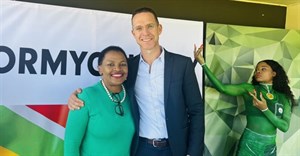The art of the brand

Recently insurance giant AIG announced that it was not going to be renewing its U$75 million sponsorship of one of the world's most successful and lucrative sporting brands, Manchester United, when the current contract ends in 2010. Formula 1 is shedding sponsors and tennis player Andy Murray, longtime beneficiary of a sponsorship from troubled bank RBS, has offered to reduce his current deal with them.
Closer to home
Closer to home, South African Airways signed a deal with golfer Angel Cabrera worth US$3 million just after announcing a series of internal cost-cutting measures, resulting in headlines and woes for its subsequently suspended CEO, Khaya Ngqula.
As the downturn slides off the news headlines and onto corporate balance sheets, it is becoming harder and harder for companies to justify to their shareholders the massive costs of “owning” sports events. A massive industry is at stake.
How big? According to BMI on behalf of Business and Arts South Africa, the numbers are staggering. In 2006 South African corporates spent R2.6 billion on sports sponsorships. The Department of Trade and Industry (dti) thinks that figure has now crept up to R3.5 billion. A similar amount is spent on leveraging those sponsorships, so assume that the industry is worth somewhere around R7 billion a year.
Teams, sporting codes and individuals used to commanding massive endorsement deals, and media owners, who benefit from the leverage behind it, are having to adjust their expectations as CEOs and financial directors begin to ask tough questions about the value to their shareholders of that mammoth spend on sport sponsorships.
Still have a job to do
But brand marketers still have a job to do and, perhaps more than ever, are looking for ways to reach through the fog of gloom to their customers and reassure them that, no matter what the state of the global economy, their favourite brand is still there for them.
Which is why the arts, an uncluttered and the biggest untapped value for money market, is poised to take over from sport.
But many sponsorship directors and their highly paid consultants still have a notion that sponsorship is about putting your logo onto something moving, preferably in front of a TV camera. It's not. And that's why they'll miss the boat. They'll also think that the way to get value from a sponsorship is to throw money at something big and to name it after their brand.
That's lazy, clumsy marketing and, frankly, both intrusive and forgettable. New marketers, however, get the essence - sponsorship is about engaging with your customers and potential customers in a space they feel passionately about. And it's not just about piggy-backing on the passion, but rather about becoming integral to their experience of it.
Once sponsors have gotten that right, and only then, can they legitimately embed their product and message into that experience, and begin reaping the benefits.
Head start
It's true that if you're talking about passions in a South African sense, sport has a head start on the arts. At least it is true on the face of it. Delve a little deeper into the traditions and customs of South Africans and you'll quickly see that while spectator sport is a diversion and a hobby about which people feel strongly, the arts is more fundamental to the fabric of who we are.
Story-telling, dance, poetry, and music is the way we have shared our experiences over the years, and the way millions of youngsters shape their identity and learn their heritage. It's isn't surprising that one of the fastest growing pasttimes in South Africa isn't soccer, rugby or road-running. It is performance poetry - edgy, creative, bold and full of attitude, today's poets are the leading voices of a generation who are taking control of their own destinies.
Creativity equals authenticity. The experience of being part of creative expression - as performer or audience or that joyous middle where the lines blur - provides an entry to the heart of South Africans that too few of our brands recognise. A staggering 43% of adult South Africans maintain that they feel more positively toward a company that sponsors the arts, according to BMI. That's a significant amount of untapped goodwill in the marketplace.
At the world's leading annual sponsorship conference hosted by IEG in Chicago, trends are detected a couple of years before they become apparent. In 2007, the conference repeated a mantra that is only now, in the context of the credit crunch, beginning to make sense. “The next big thing,” IEG said, “is a million little things.”
Fragment
In other words, as consumers fragment themselves into smaller and smaller communities, become more inward looking and respond only to those things that have a direct impact on their lives, marketers need to avoid the “one size fits all, big bang” sponsorship that shouts loudly but speaks to no-one. Instead of the shotgun, a carefully aimed rifle is needed.
Consumers have changed over the years. Today they cynically reject the notion that big brands are better simply because they are big brands. Seeing your logo plastered around a sports ground doesn't make anyone rush out to try what you're selling for the first time, and in a stadium environment there are few opportunities to engage and “close the deal”.
Advocates of the shotgun-style of wallpapering a stadium or team argue that it is about getting your brand out there. In the '90s, when “brand awareness” was the buzzword that would have been a sensible strategy. Today, “brand awareness” doesn't necessarily translate into “brand consumption” or even “goodwill toward brand”.
In fact, given the rising cynicism of consumers and the economic climate, a show-offy big bang approach to sponsorship is just as likely to backfire and cause resentment among consumers.
Want to belong
More than ever consumers want to belong (witness the rise of social media - Twitter, YouTube, Facebook - they're all enablers of one-to-one communication and building micro communities), consumers want to care and think deeply about the world around them and relate to leaders who don't patronise them (Barrack Obama). They crave authenticity, community and the human touch in a world where they are increasingly alienated from the economy, politicians and their neighbours.
And where are they more likely to find those authentic, genuine connections - as one of 70 000 people at Newlands, or in a quiet, darkened theatre experiencing an intimate, goose bump-inducing moment of magic?
In part two, I'll take a look at how a tiny slice of your sports budget can make a massive impact in the arts world.

















